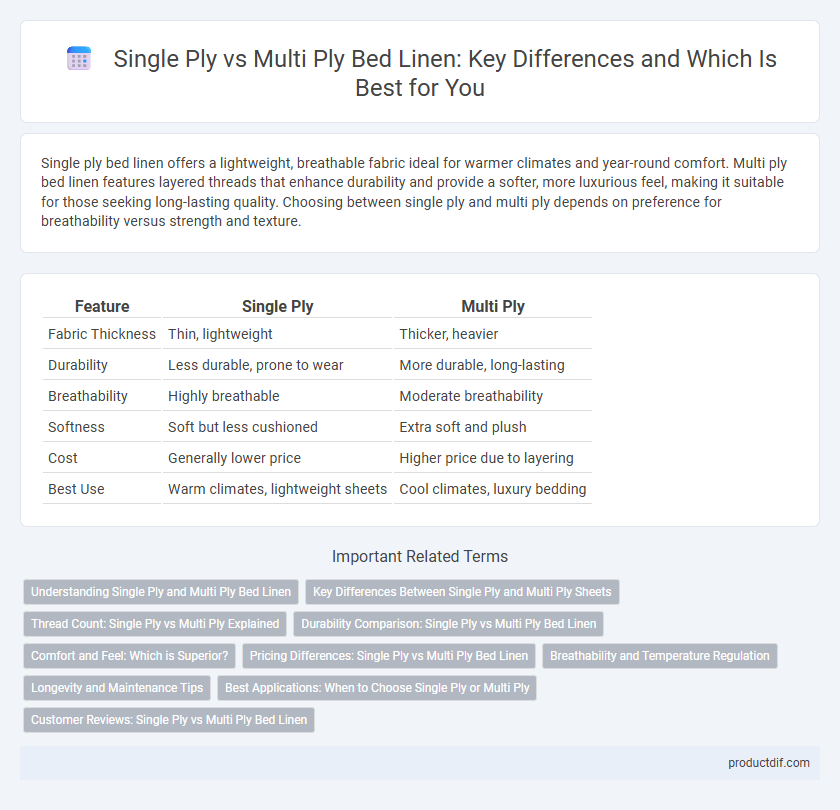Single ply bed linen offers a lightweight, breathable fabric ideal for warmer climates and year-round comfort. Multi ply bed linen features layered threads that enhance durability and provide a softer, more luxurious feel, making it suitable for those seeking long-lasting quality. Choosing between single ply and multi ply depends on preference for breathability versus strength and texture.
Table of Comparison
| Feature | Single Ply | Multi Ply |
|---|---|---|
| Fabric Thickness | Thin, lightweight | Thicker, heavier |
| Durability | Less durable, prone to wear | More durable, long-lasting |
| Breathability | Highly breathable | Moderate breathability |
| Softness | Soft but less cushioned | Extra soft and plush |
| Cost | Generally lower price | Higher price due to layering |
| Best Use | Warm climates, lightweight sheets | Cool climates, luxury bedding |
Understanding Single Ply and Multi Ply Bed Linen
Single ply bed linen is woven from a single strand of yarn, offering a lighter, softer texture ideal for warmer climates and those who prefer breathable fabric. Multi ply bed linen consists of multiple yarn strands twisted together, resulting in a thicker, more durable material that provides enhanced strength and longevity. Choosing between single ply and multi ply hinges on desired comfort, fabric weight, and durability preferences within bedding.
Key Differences Between Single Ply and Multi Ply Sheets
Single ply bed sheets consist of a single layer of fabric, providing a lightweight and breathable feel ideal for warmer climates. Multi ply sheets are made from multiple layers or plies of yarn twisted together, resulting in increased thickness, durability, and softness for added comfort and long-term use. Key differences include breathability, texture, and durability, with single ply favoring airflow and ease of maintenance, while multi ply offers enhanced strength and a plush, luxurious feel.
Thread Count: Single Ply vs Multi Ply Explained
Thread count measures the number of threads per square inch of fabric, with single ply threads counted individually, offering a more accurate representation of fabric quality. Multi ply threads are made by twisting two or more threads together, which can inflate thread count numbers but may not reflect superior durability or softness. Choosing single ply bed linen often results in a smoother, more breathable fabric compared to multi ply options that can feel heavier and less comfortable.
Durability Comparison: Single Ply vs Multi Ply Bed Linen
Single ply bed linen is made from a single layer of yarn, offering a lightweight feel but generally lower durability compared to multi ply options. Multi ply bed linen uses multiple strands twisted together, resulting in stronger fabric that resists wear and tear over time. For long-lasting durability, multi ply bed linen is preferred due to its enhanced strength and ability to maintain quality through frequent washing.
Comfort and Feel: Which is Superior?
Single ply bed linens offer a lightweight, breathable feel ideal for warm climates or those who prefer a softer, less dense fabric. Multi ply linens provide enhanced durability and a plush, thicker texture, resulting in a cozy and luxurious sleeping experience. Comfort preferences vary, but multi ply bed linen generally delivers superior softness and longevity compared to single ply options.
Pricing Differences: Single Ply vs Multi Ply Bed Linen
Single ply bed linen typically costs less due to its simpler manufacturing process and lower material usage, making it an economical choice for budget-conscious shoppers. Multi ply bed linen, often made from multiple woven layers or higher thread counts, commands higher prices reflecting enhanced durability, softness, and luxury. The price gap between single ply and multi ply options can influence purchasing decisions depending on preferences for quality versus cost-effectiveness.
Breathability and Temperature Regulation
Single ply bed linen offers superior breathability due to its lighter fabric, allowing better air circulation for a cooler sleep experience. Multi ply linens, with their layered construction, provide enhanced insulation, making them ideal for retaining warmth in colder conditions. Choosing between single ply and multi ply depends on personal temperature preferences and climate needs for optimal comfort.
Longevity and Maintenance Tips
Single ply bed linen, made from a single layer of fibers, tends to be softer but less durable than multi ply options, which feature multiple twisted yarns for enhanced strength and longevity. Multi ply sheets resist pilling and wear better over time, making them ideal for frequent washing and long-term use. To maximize lifespan, wash bed linen in cold water with gentle detergent, avoid bleach, and rotate sets regularly to minimize fabric stress.
Best Applications: When to Choose Single Ply or Multi Ply
Single ply bed linen, made from a single layer of yarn, offers a lighter, more breathable fabric ideal for warm climates or summer months, enhancing comfort with its smooth texture. Multi ply bed linen consists of multiple yarn layers twisted together, providing increased durability, thickness, and warmth, making it perfect for colder seasons or heavy-use environments such as hotels. Selecting single ply is best for softness and breathability, while multi ply excels in strength and longevity.
Customer Reviews: Single Ply vs Multi Ply Bed Linen
Customer reviews highlight that single ply bed linen is praised for its lightweight feel and breathability, making it ideal for warmer climates and sensitive skin. Multi ply bed linen often receives positive feedback for its enhanced durability, plush texture, and superior warmth, favored in colder seasons or for long-term use. Overall satisfaction depends on personal preferences related to comfort, maintenance, and climate, with many customers valuing the softness of single ply and the robustness of multi ply fabrics.
Single Ply vs Multi Ply Infographic

 productdif.com
productdif.com